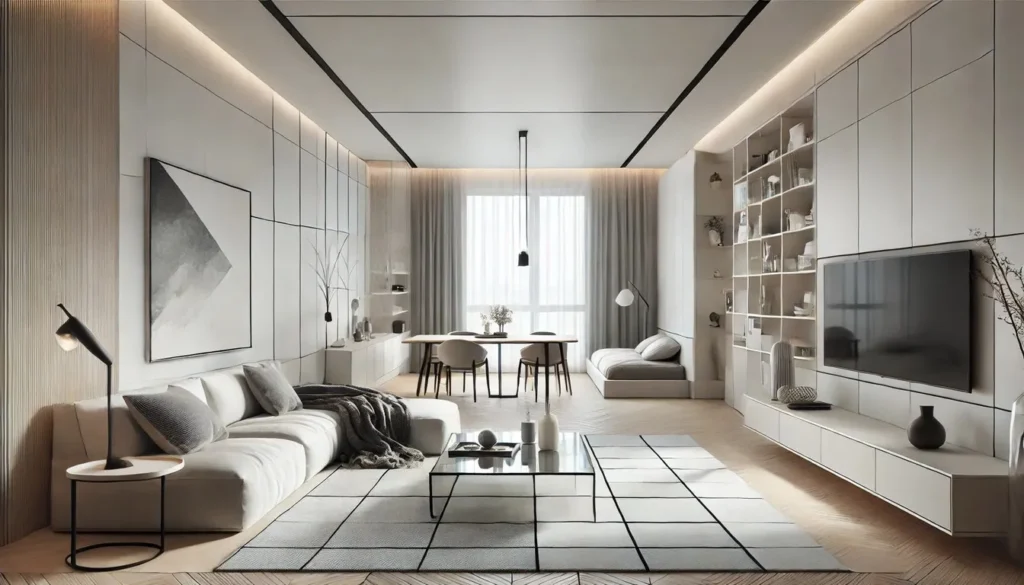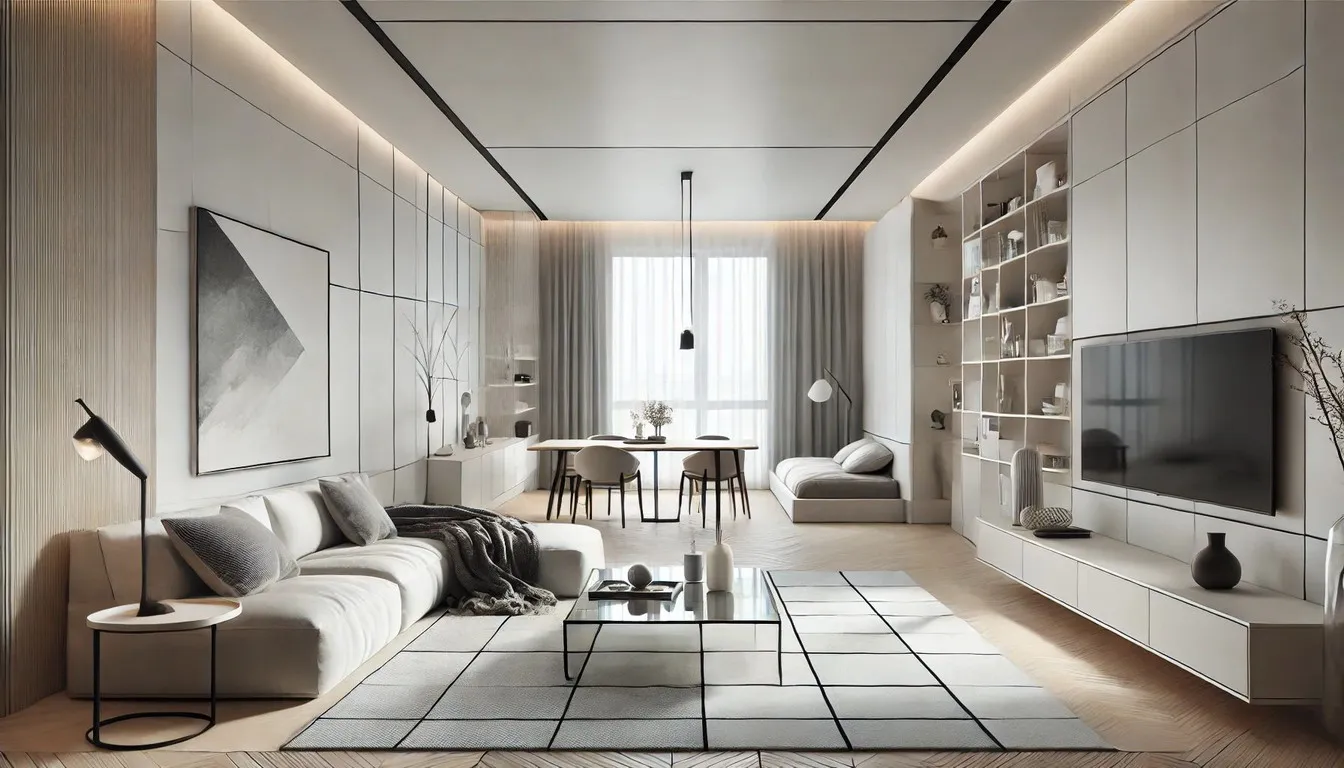Modern minimalist interior decor is a design philosophy that focuses on simplicity, functionality, and a clean aesthetic. It emphasizes the use of space, light, and essential furnishings to create a serene and uncluttered environment. This approach not only enhances the visual appeal of a home but also promotes a sense of calm and order. In this article, we will explore the key principles of modern minimalism, provide practical tips for decluttering and organizing, and offer ideas for creating a stylish minimalist home.

Understanding Modern Minimalism
The concept of minimalism in interior design has its roots in the early 20th century, influenced by movements such as De Stijl and Bauhaus. These movements emphasized simplicity, geometric forms, and the use of industrial materials. Modern minimalism takes these principles further by focusing on creating functional and aesthetically pleasing spaces that are free of excess.
Core Principles of Minimalism:
- Simplicity: The mantra “less is more” is central to minimalist design. This means eliminating unnecessary elements and focusing on the essentials.
- Functionality: Every item in a minimalist space should have a purpose. This includes furniture, decor, and even architectural features.
- Clean Lines: Minimalist interiors often feature straight, clean lines and geometric shapes, which contribute to a streamlined look.
- Neutral Color Palettes: Colors in minimalist design are typically subdued and neutral, creating a calming atmosphere. Whites, grays, blacks, and earth tones are commonly used.
Decluttering and Organizing
One of the first steps in adopting a minimalist decor style is decluttering. Removing excess items not only makes a space look cleaner but also enhances its functionality. Here are some effective decluttering tips:
- Sort and Categorize: Begin by sorting your belongings into categories such as clothes, books, and kitchen items. Decide what to keep, donate, or discard based on their usefulness and emotional value.
- The “One In, One Out” Rule: To maintain a clutter-free home, adopt the rule of letting go of one item for every new item you bring in. This helps prevent accumulation.
- Storage Solutions: Invest in storage solutions that help keep items out of sight but easily accessible. This includes cabinets, baskets, and under-bed storage.
Choosing the Right Color Palette
Color plays a significant role in minimalist decor. A neutral color palette creates a sense of calm and space, making rooms appear larger and more open.
Popular Color Schemes:
- Whites and Grays: These colors form the foundation of minimalist interiors. They reflect light, making spaces feel airy and bright.
- Muted Tones: Soft, muted tones such as beige, taupe, and light pastels add warmth without overwhelming the space.
- Accent Colors: While neutral colors dominate, a few well-chosen accent colors can add interest. Use them sparingly in the form of cushions, artwork, or rugs.
Tips for Selecting Colors:
- Consistency: Stick to a cohesive color scheme throughout your home to create a unified look.
- Contrast: Use contrasting shades to add depth and dimension. For example, pair white walls with dark furniture.
- Natural Elements: Incorporate natural materials like wood and stone, which have their own inherent colors and add texture to the space.
Furniture Selection
Furniture in a minimalist home should be simple, functional, and of high quality. It should blend seamlessly with the overall design while providing comfort and utility.
Key Characteristics of Minimalist Furniture:
- Sleek and Simple Designs: Look for furniture with clean lines and minimal ornamentation. Pieces should have a straightforward and unembellished design.
- Multi-Functional Pieces: To maximize space and utility, choose furniture that serves multiple purposes, such as a sofa bed or a coffee table with storage.
- Quality Over Quantity: Invest in fewer pieces of higher quality. Well-made furniture lasts longer and enhances the overall aesthetic.
Examples of Minimalist Furniture for Different Rooms:
- Living Room: A low-profile sofa, a simple coffee table, and a few well-placed shelves.
- Bedroom: A platform bed, a sleek nightstand, and a minimalist dresser.
- Kitchen: Clean-lined cabinets, a functional island, and uncluttered countertops.
Incorporating Natural Elements
Natural elements add warmth and texture to minimalist interiors, preventing them from feeling sterile. They also create a connection to the outdoors, promoting a sense of well-being.
Benefits of Bringing Nature Indoors:
- Aesthetic Appeal: Natural materials like wood, stone, and metal have unique textures and colors that enhance the visual interest.
- Health Benefits: Plants improve air quality and create a calming atmosphere.
- Sustainability: Using natural and eco-friendly materials supports sustainable living practices.
Ideas for Integrating Natural Materials:
- Wood Accents: Use wooden furniture, flooring, or beams to add warmth. Choose light or medium finishes to maintain a minimalist look.
- Stone Elements: Incorporate stone in countertops, backsplashes, or decorative pieces.
- Indoor Plants: Select low-maintenance plants like succulents, snake plants, or peace lilies. Place them in simple pots that complement your decor.
Lighting and Ambiance
Lighting is crucial in minimalist interiors. It highlights architectural features, creates mood, and enhances functionality.
Role of Lighting in Minimalist Decor:
- Natural Light: Maximize natural light by using large windows and keeping window treatments minimal. Light-filled spaces feel more open and inviting.
- Artificial Lighting: Use a combination of ambient, task, and accent lighting to create a balanced and functional space.
Tips for Creating a Warm and Inviting Atmosphere:
- Layered Lighting: Combine different types of lighting to add depth. For example, use overhead lights, floor lamps, and table lamps together.
- Dimmer Switches: Install dimmer switches to control light intensity and create different moods.
- Warm Bulbs: Choose warm white bulbs to create a cozy and inviting ambiance.
Art and Accessories
While minimalism emphasizes simplicity, art and accessories can add personality and character to your home. The key is to choose items that complement the overall design without overwhelming it.
How to Choose and Display Art:
- Focus on Statement Pieces: Select one or two large artworks that draw attention. This avoids clutter and creates a focal point.
- Simple Frames: Use simple, unadorned frames to keep the focus on the art itself.
- Clean Lines: Hang art at eye level and maintain clean lines and symmetry in your display.
Selecting Accessories that Complement Minimalist Aesthetics:
- Functional Decor Items: Choose accessories that are both decorative and functional, such as stylish storage baskets or elegant clocks.
- Minimalist Clocks and Mirrors: Use sleek, modern clocks and mirrors to add interest without clutter.
- Textiles: Add softness and texture with minimalistic cushions, throws, and rugs in neutral colors.
Personalizing Your Space
Minimalism doesn’t mean sacrificing personal touches. It’s about balancing minimalism with individuality to create a space that reflects your personality.
Adding Personal Touches While Maintaining a Minimalist Look:
- Meaningful Decor: Display items that have sentimental value or tell a story, but keep them few and well-curated.
- Custom Artwork: Consider custom or DIY art that reflects your interests and style.
- Books and Collections: Showcase a small, curated collection of books or other items that are meaningful to you.
Examples of Personalized Minimalist Spaces:
- Living Room: A clean-lined sofa with a few personal photos in simple frames, a minimalist bookshelf with your favorite books and a few decorative objects.
- Bedroom: A neutral bedspread with a couple of personal cushions or throws, a nightstand with a meaningful keepsake.
- Home Office: A functional desk with minimal clutter, a wall-mounted shelf with personal items that inspire you.
Embracing modern minimalist interior decor can transform your home into a sleek, stylish, and serene space. By focusing on simplicity, functionality, and clean lines, you can create an environment that not only looks beautiful but also promotes a sense of calm and order. Remember to declutter regularly, choose a cohesive color palette, invest in quality furniture, and incorporate natural elements to enhance the aesthetic. Personalize your space thoughtfully to maintain a minimalist look while reflecting your individuality. With these tips and ideas, you’re well on your way to achieving a modern minimalist home that is both functional and inviting.
Additional Resources
- Books: “The Life-Changing Magic of Tidying Up” by Marie Kondo, “Minimalism: A Documentary About the Important Things” by Joshua Fields Millburn and Ryan Nicodemus.
- Websites: Minimalist Baker (minimalistbaker.com), The Minimalists (theminimalists.com).
- Blogs: Zen Habits (zenhabits.net), Be More with Less (bemorewithless.com).
- Stores: IKEA, Muji, West Elm, CB2, Crate & Barrel.
By following the principles and tips outlined in this article, you can achieve a modern minimalist interior that is not only aesthetically pleasing but also enhances your quality of life. Embrace the beauty of simplicity and create a home that truly reflects your style and values.









